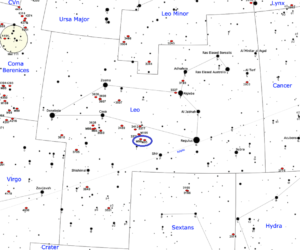Messier 95 (M95) is a barred spiral galaxy located in the constellation Leo. It lies at a distance of 32.6 million light years from Earth. Messier 95 is home to around 40 billion stars and has a well-defined spiral structure. It has nearly circular spiral arms and is classified as a type SBb or SB(r)b barred spiral. The galaxy’s central bar is surrounded by tightly wound spiral arms dotted by star forming regions, dust lanes and clusters of young, blue stars. Messier 95 contains a ring-like circumnuclear star-forming region at its centre. The region has a diameter of 2,000 light years. The star formation within the ring is arranged in clumps, each about 60 to 85 parsecs in diameter. Each of the clumps contains compact young clusters of stars. The galaxy’s core is where most of the star forming activity is taking place.
| Description | |
| Visible From Pacific Northwest | December to May |
| Best Time To Observe | Apri |
| Minimum Size Of Viewing Device | Small Telescope |
| Object Type | Barred Spiral Galaxy |
| Designations | Messier 95, M95, NGC 3351, PGC 32007, UGC 5850, Z 66-4, Z 1041.4+1158, ALFALFA 5-309, IRAS 10413+1158, 2MASX J10435773+1142129, MCG+02-28-001, TC 726, UZC J104357.8+114214 |
| Right Ascension | 10h 43m 57.7s |
| Declination | +11°42’14” |
| Constellation | Leo |
| Number Of Stars | 40,000,000,000 (40 Billion) |
| Apparent magnitude | +11.4 |
| Apparent dimensions | 3′.1 x 2′.9 |
| Object Radius | 23,000 light yeas |
| Distance From Earth | 32,600,000 light years |
History
Messier 95 was discovered by the French astronomer Pierre Méchain on March 20, 1781, along with the nearby Messier 96. Méchain reported the discovery to Charles Messier, who added both galaxies to his catalogue on March 24, 1781. He described M95 as a “nebula without a star, in the Lion, above star l (53 Leonis),” adding that “its light is very faint.”
John Herschel catalogued the object as h 743 and later included it in his General Catalogue as GC 2184. He described it as “bright; large; round; pretty gradually much brighter toward the middle where there is a nucleus.”
Locating M95 In The Sky
Messier 95, the nearby intermediate spiral galaxy M96, and the elliptical M105 can be found roughly a third of the way from Regulus, the brightest star in Leo, to Denebola, the third brightest star in the constellation, which lies about 24 degrees east of Regulus. M105 is the northernmost galaxy in the group and M96, the brightest of the three, is located 50 arc minutes south of M105. M95 lies 40 arc minutes to the west of M96. The best time of year to observe M95 and the nearby galaxies is during the spring.

Viewing M95
In large binoculars, it only shows up as a hazy smudge, but it can easily be seen in small telescopes. 6-inch and 8-inch telescopes reveal a diffuse oval ball of light with a brighter centre, and the galaxy’s bar structure is only visible under exceptionally good conditions.
Photographing M95
Because of their small size and great amount of detail, each galaxy is best photographed with a large telescope, such as 12” or bigger. If using an 8” telescope or smaller, like us, you can center the view right in between M96 and M95. By doing so, you will be able to capture several galaxies from the M96 Group.
Processing can be a little tricky in a sense that you need to keep an eye on each of those worlds, and keep their brightness, saturation, and crispness similar to each other.
Sources And Further Reading
Descriptions of all of Messier Objects can be found here.
https://www.nasa.gov/feature/goddard/2018/messier-95
https://freestarcharts.com/messier-95
https://www.messier.seds.org/m/m095.html
https://www.galactic-hunter.com/post/m96-group-8-galaxies-in-the-constellation-of-leo

Be the first to comment on "Messier 95"